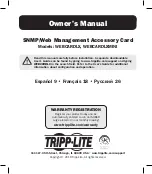
Glossary
– 596 –
DiffServ
Differentiated Services provides quality of service on large networks by employing a well-
defined set of building blocks from which a variety of aggregate forwarding behaviors may
be built. Each packet carries information (DS byte) used by each hop to give it a particular
forwarding treatment, or per-hop behavior, at each network node.
DiffServ
allocates
different levels of service to users on the network with mechanisms such as traffic meters,
shapers/droppers, packet markers at the boundaries of the network.
DNS
Domain Name Service. A system used for translating host names for network nodes into IP
addresses.
DSCP
Differentiated Services Code Point Service. DSCP uses a six-bit tag to provide for up to 64
different forwarding behaviors. Based on network policies, different kinds of traffic can be
marked for different kinds of forwarding. The DSCP bits are mapped to the Class of Service
categories, and then into the output queues.
EAPOL
Extensible Authentication Protocol over LAN. EAPOL is a client authentication protocol used
by this switch to verify the network access rights for any device that is plugged into the
switch. A user name and password is requested by the switch, and then passed to an
authentication server (e.g., RADIUS) for verification. EAPOL is implemented as part of the
IEEE 802.1X Port Authentication standard.
ERPS
Ethernet Ring Protection Switching can be used to increase the availability and
robustness of Ethernet rings, such as those used in Metropolitan Area Networks
(MAN). ERPS provides Layer 2 loop avoidance and fast re-convergence in Layer 2
ring topologies, supporting up to 255 nodes in the ring structure. It can also
function with IEEE 802.1ag to support link monitoring when non-participating
devices exist within the Ethernet ring.
EUI
Extended Universal Identifier is an address format used by IPv6 to identify the host portion
of the network address. The interface identifier in EUI compatible addresses is based on the
link-layer (MAC) address of an interface. Interface identifiers used in global unicast and
other IPv6 address types are 64 bits long and may be constructed in the EUI-64 format. The
modified EUI-64 format interface ID is derived from a 48-bit link-layer address by inserting
the hexadecimal number FFFE between the upper three bytes (OUI field) and the lower 3
bytes (serial number) of the link layer address. To ensure that the chosen address is from a
unique Ethernet MAC address, the 7th bit in the high-order byte is set to 1 (equivalent to
the IEEE Global/Local bit) to indicate the uniqueness of the 48-bit address.
GARP
Generic Attribute Registration Protocol. GARP is a protocol that can be used by endstations
and switches to register and propagate multicast group membership information in a
switched environment so that multicast data frames are propagated only to those parts of a
switched LAN containing registered endstations. Formerly called Group Address
Registration Protocol.
Summary of Contents for EX-3524
Page 2: ......
Page 28: ...Figures 28 ...
Page 34: ...Section I Getting Started 34 ...
Page 58: ...Chapter 1 Initial Switch Configuration Setting the System Clock 58 ...
Page 72: ...Chapter 2 Using the Command Line Interface CLI Command Groups 72 ...
Page 156: ...Chapter 5 SNMP Commands Notification Log Commands 156 ...
Page 164: ...Chapter 6 Remote Monitoring Commands 164 ...
Page 218: ...Chapter 7 Authentication Commands Management IP Filter 218 ...
Page 268: ...Chapter 8 General Security Measures Port based Traffic Segmentation 268 ...
Page 292: ...Chapter 9 Access Control Lists ACL Information 292 ...
Page 312: ...Chapter 10 Interface Commands Power Savings 312 ...
Page 324: ...Chapter 11 Link Aggregation Commands Trunk Status Display Commands 324 ...
Page 366: ...Chapter 15 Address Table Commands 366 ...
Page 428: ...Chapter 17 VLAN Commands Configuring Voice VLANs 428 ...
Page 572: ...Chapter 25 IP Interface Commands IPv6 Interface 572 ...
Page 578: ...Section I Appendices 578 ...
















































